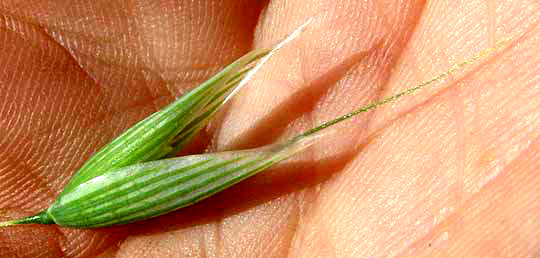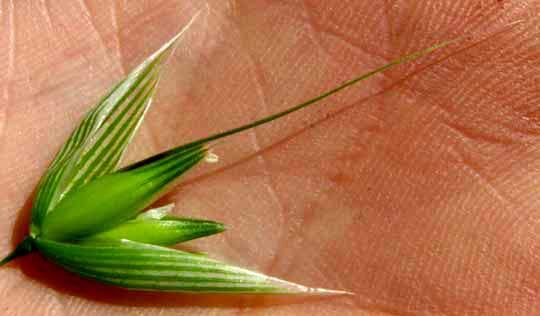Excerpts from Jim Conrad's
Naturalist Newsletter
from the April 29, 2012 Newsletter issued from the woods of the Loess Hill Region a few miles east of Natchez, Mississippi, USA
ROADSIDE OATS
Wandering backroads on my bike I spotted a grass unlike the millions of others I'd passed by. You can see how it distinguished itself with its open panicle of a few oversized, dangling spikelets below:

A spikelet plucked from the panicle is shown below:

The same spikelet opened to show the florets inside the glumes is next:

This is Oat grass, AVENA SATIVA, the same species producing the oats of oatmeal. Oat spikelets differ from those of the vast majority of other grasses by the very large, boat-shaped glumes subtending the florets.
Glumes are analogous to a regular flower's calyx, so in that last picture of a spikelet, the glumes are the two large, green-and-white striped items at the left in the photograph. The vast majority of grass spikelets bear glumes much shorter than the florets above them. Also, notice that the slender, stiff, needlelike item, the awn, arises from a floret inside the spikelet and not from a glum.
Remember that you can review grass flower terminology at http://www.backyardnature.net/fl_grass.htm.
The spikelets of most Oat plants don't bear needlelike awns. You're likely to see both awned and awnless kinds growing as weeds in our area. When I first saw the awns I thought this might be one of the "Wild Oat" species, for several species reside in the Oat genus Avena, and one of those grows wild in the US Southeast. However, florets of the other species bear long, brownish hairs, and you can see that ours are hairless, or "glabrous." The other species' awns also are twisted, but regular Oat awns, when present, are rigid and straight. Both Oat species are native to Eurasia.
How did that Oat plant make its way to the side of our isolated Mississippi backroad? Near where the grass grew there was a large game farm where exotic animals are kept so hunters can pay high fees to kill them. I'm betting that the animals are fed oats. Our plant was in an often-flooded spot downstream from the farm, so maybe an oat grain had washed there.